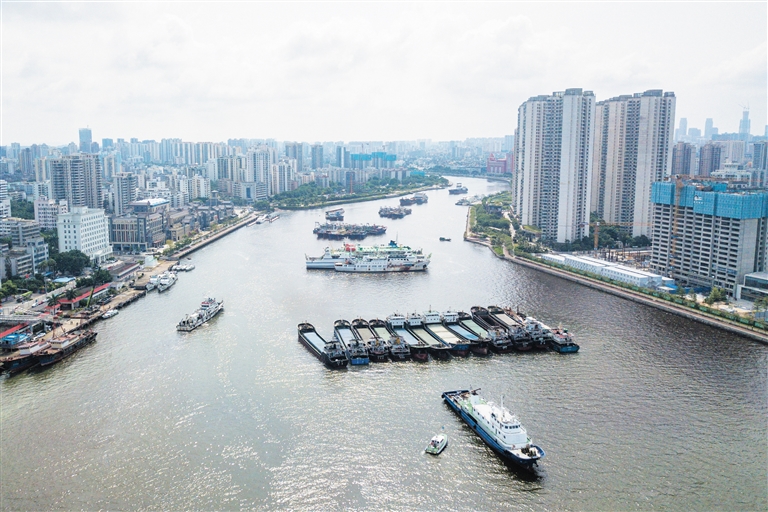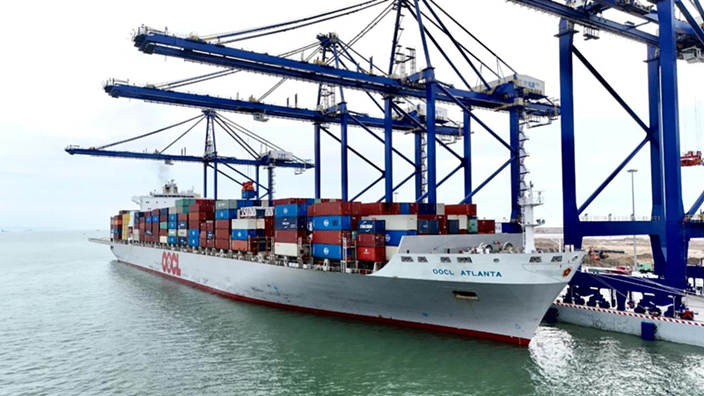
Typhoon Yagi, which is fast approaching Hainan, was upgraded to a "Super Typhoon" (level 17 or above with wind speeds between 56.1 - 63 m/s) in the late hours of September 4. It is expected to make landfall somewhere between the north coast of Hainan Island and Dianbai District in Maoming City, Guangdong Province, in the afternoon or evening of the 6th. Current projections narrow the most likely landing area to between Wenchang City in Hainan and Xuwen County in Guangdong.

Ships take shelter from the approaching Typhoon Yagi at the Xingang Port in Haikou, Hainan province, on Sept 4, 2024. (Photo: Xinhua)
Steps to take before a typhoon arrives
Check forecasts: Monitor typhoon forecasts issued by meteorological agencies to determine the typhoon's direction and likely impact. The WeChat mini-program "台风路径" (Typhoon Tracker) allows near real-time tracking of typhoons arising in the northwest Pacific or South China Sea.
Stock up: Prepare necessary food, drinking water, medicines, emergency lights, and other emergency equipment in advance, and ensure that your mobile phone has sufficient power.
Move things indoors: Move potted plants and other loose items off your balcony and roof and away from windows in a timely manner. If your home is in a low-lying or flood-prone area, move furniture, electrical appliances, and other items to higher ground.
Secure or dismantle: Reinforce and secure doors and windows, outdoor hanging objects and installations, high-altitude facilities and equipment, and temporary buildings. Dismantle if necessary.
Inspect: Check electrical circuits, gas pipes, liquefied gas equipment, and other utility supply equipment to ensure they are safe.
Keep your car out of harm's way: Park your car on high ground and avoid parking it on the roadside beneath trees and other objects such as pylons and signposts or on flood-prone roads. Ensure your car's wipers, lights, and electrical systems function normally.
Precautions when a typhoon strikes
Avoid going outside: Except in absolute emergencies, stay indoors inside a safe, stable building, with windows and doors securely closed and away from windows and doors facing the wind. You should not go to or engage in any activities in dangerous areas such as the seaside. If you are driving, avoid low-lying flooded roads and underpasses wherever possible. A sudden drop in wind and rain may indicate that the eye of the typhoon is passing overhead. Do not go outside. Wait until the storm has passed and warnings have been lifted.
Keep yourself out of harm's way: People living in low-lying areas or areas prone to floods, landslides, etc., should make their own arrangements or follow government or work unit arrangements to evacuate these areas.
Stay calm and take initiative: If you are trapped by floods or your location is struck by mountain torrents, stay calm, try to save yourself, and call the police (110) for help.
Precautions after the typhoon passes
Check indoor wiring and other utilities: After a typhoon, check your gas, tap water, electrical wiring, and other utilities in a timely manner. If you find any safety issues, such as short circuits or leaks, report them.
Stay away from potential disaster areas: After a typhoon, geological disasters such as landslides and mud avalanches are more likely to occur in certain places, such as mountainous areas. Stay away from these areas.
Post-flood disinfection: Disinfection and sterilization work should be carried out promptly in homes and public places that were flooded to prevent the spread of disease.
Overseas Chinese Architecture in Hainan ④: Shibahang Village’s Code of Unity
05:47, 27-June-2025World Insect Week: Fantastic Flying Creatures in Hainan’s Rainforests
05:47, 27-June-2025Yangpu International Container Terminal Opens Direct Shipping Route to India
05:47, 27-June-2025It's time for Hainan "Village VA"!
03:13, 26-June-2025Surprise Delivery of Hainan Gifts!
03:13, 26-June-2025One invitation and they came to Hainan right away! Look, they are arriving!
03:12, 26-June-2025By continuing to browser our site and use the services you agree to our use of cookies, Privacy Policy and Terms of Use. You can change your cookie settings through your browser.





